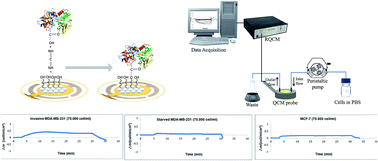Quartz crystal microbalance based biosensors for detecting highly metastatic breast cancer cells via their transferrin receptors†
Abstract
A quartz crystal microbalance (QCM) biosensor was developed to detect highly metastatic breast cancer cells by functionalizing the gold sensor surface with transferrin attachment. MDA-MB 231 breast cancer cells with high and MCF 7 cells with low metastatic potential and transferrin expression were used. Serum starved MDA-MB-231 cells were used as control cells. First, poly(2-hydroxyethyl methacrylate) (PHEMA) nanoparticles were prepared by mini-emulsion polymerization of hydroxyethyl methacrylate (HEMA) and ethylene glycol dimethacrylate (EGDMA). Nanoparticles were characterized with a zeta-sizer and then their suspension is dropped on the surface of the QCM and the dried QCM surface was modified further by activation with carbodiimide and transferrin attachment. The QCM biosensor was analyzed by using atomic force microscopy (AFM), ellipsometry, Fourier transform infrared spectrophotometry (FTIR) and contact angle measurements. The cells were applied to the derivatized QCM sensor to investigate the affinity and binding kinetics. The nanoparticles and transferrin were found to form a monolayer on the QCM surface. Binding kinetics were best fitted to the Langmuir–Freundlich adsorption model. The QCM signal was correlated well with the number of transferrin receptors on cells. It is concluded that the QCM biosensor functioning via transferrin receptor interactions may be used to detect breast cancer cells with high metastatic potential.


 Please wait while we load your content...
Please wait while we load your content...